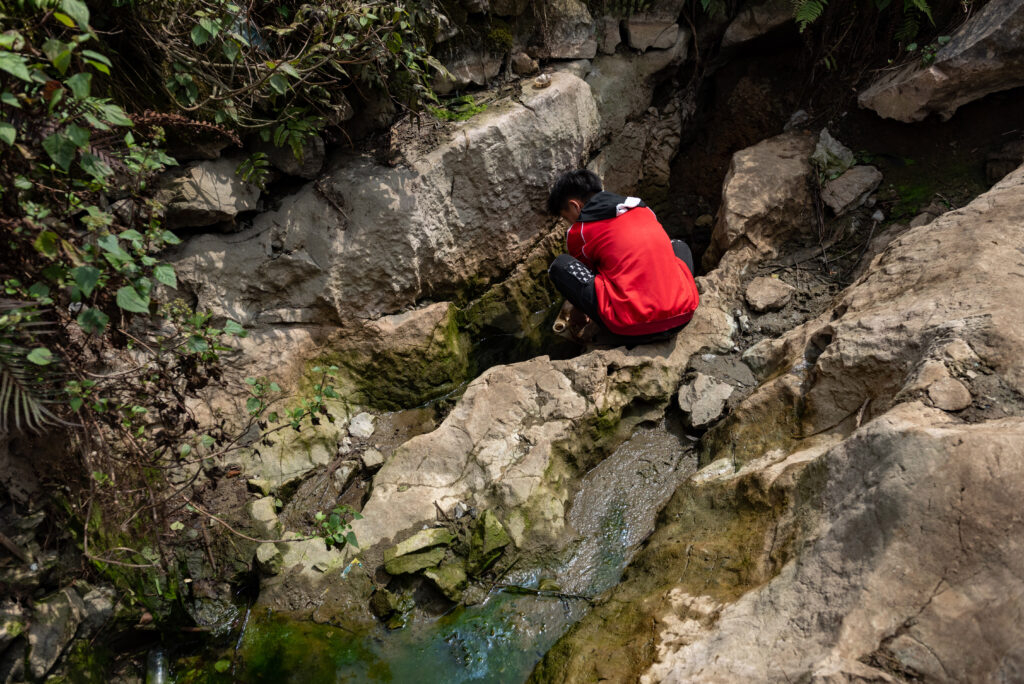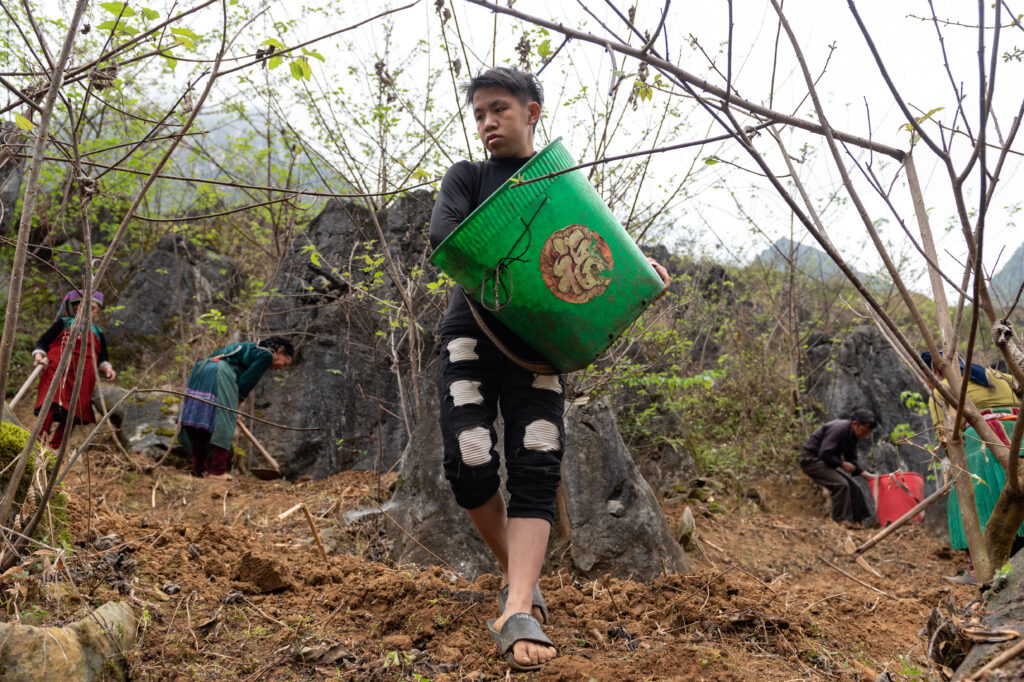HÀ GIANG, VIỆT NAM – For 17-year-old Vàng Mí Say, a typical school day doesn’t end with homework. After classes, he heads off on a two-kilometer trek to a dwindling stream, the nearest water source from his home.
One hour later he returns home, carrying a 20-liter water can on his back and a bucket of freshly washed clothes on his chest.
This journey is not a choice – it’s a must. The water he gets will sustain his family for the next two days.
Perched high in Viet Nam’s northern mountains, the Dong Van Karst Plateau presents a captivating, yet unforgiving landscape. This UNESCO Global Geopark, adorned with dramatic limestone peaks and plunging valleys, attracts tourists seeking to see its natural beauty.
But for those who call it home, survival hinges on a scarce and precious resource: water.

Known as the “thirsty rocky region”, the plateau gets ample rainfall, but lacks the means to retain it. Its steep slopes and rocky terrain make water collection difficult, and underground reserves are virtually nonexistent.
Residents depend on rainwater stored in mountain and household reservoirs, but in the dry season, which stretches from November to April and is becoming both longer and more severe.
“Tsi muaj lub roob siab dua koj lub hauv caug” – “There is no mountain higher than the Hmong’s knees,” the old proverb goes, a testament to the resilience of the Hmong, who make up 90% of the Đồng Văn Karst Plateau’s population.
Yet climate change is testing this wisdom. The shift had been gradual and barely noticeable until last year, when drought wiped out corn crops en masse, costing Đồng Văn district a total of VND 1,9 billion (US$78,000) in damage.
“The sky brings rain, but it arrives late in July,” Sá, Say’s father, says. “By then, even weeds can’t live, so how can the corn survive?”

Vanishing water
For Say and his commune of more than 3,500 Hmong people in Tả Phìn, their arduous daily quest for water has become increasingly difficult over the past decades.
In Tả Phìn and the nearby Sà Phìn commune, there are no rivers or streams. Scorching temperatures and the demands of thousands of people evaporates the limited reservoirs, forcing villagers on increasingly desperate treks to dwindling natural water sources.
As the drought worsens, their journeys lengthen.


In 2014, Say and his younger brother moved to their grandparents’ house to pursue their studies. Following their grandfather’s death two years ago, the brothers took on the responsibility of fetching water during the unrelenting dry season.
On hour-long hikes, communication was minimal, replaced by the sound of footsteps and the unsaid question of what “not going” meant.
“I don’t like it, but I want to help my grandma,” he said. Every day, the once-heavy 20-liter water feels a little lighter for him.


Say’s story of his long trek for water is not new.
His father, Vàng Mi Sá, 43, recalls his childhood days shaped by a daily quest: At the age of six, twice a day, he’d join a group of 20–30 children who would trek two kilometers uphill to collect water in five-liter cans.
As nearby sources dried up, Sá’s search gradually extended to distant towns, turning water-fetching into an all-day affair. Water scarcity in this mountainous region necessitates careful use; residents often gather week-long laundry for washing trips to nearby streams or mountain reservoirs.

The water problem affects all aspects of life on the plateau. Even schools are not spared.
At the Tả Phìn Primary and Secondary Semi-Boarding School for Ethnic Minorites, where Say and his brother study, principal Phạm Xuân Khải spends VND 500,000 ($20) daily on a truck which delivers only three cubic meters of water to serve 425 boarding students.
This shared water must cover both cooking and personal hygiene needs. Strict rationing measures are in place. The students are allotted 30 minutes in the morning and one hour in the afternoon for water use.
Located 15 kilometers away with 24 tanks and man-made reservoirs, the Sà Phìn Primary and Secondary Semi-Boarding School for Minority Students struggles to meet its water needs for its 442 boarding students.
“We bought 10 water trucks before the Lunar New Year and nearly 40 since,” principal Lương Minh Hoạt estimated.




The Sà Phìn commune relies on a dwindling network of mountain reservoirs. Two of the three reservoirs have now dried up and the only water source is the reservoir in Lũng Hoà A village, four kilometers away.
Principal Hoạt secured a discounted rate of VND 350,000 ($14) for each three cubic meter water tank, thanks to the attendance of students from that village. Usually, the village’s precious resource remains inaccessible to outsiders.
With no budget for water, Hoạt has been seeking emergency funding from local authorities and social resources for years. Parents of school students, recognizing the ongoing crisis, had to chip in to ensure their children’s access to water.


In Lũng Phìn commune, 30km from Dong Van town, 51-year-old farmer Và Dũng Chơ is also forced to buy water.
It costs Chơ VND 1,500,000 ($60) for eight cubic meters, which is enough for his family, but not for his barren fields. Last year’s harvest loss still weighs heavily on him, and he fears this year may be no different.
A looming crisis
To combat the persistent water scarcity on the plateau, the government has prioritized the construction of numerous domestic water supply projects. The Institute of Geology led a landmark project in 2002 that created a 3,000 cubic meter pilot reservoir in Sa Phin commune.
Although short-lived, this project offered initial hope for a solution. Presently, the Đồng Văn Department of Agriculture and Rural Development reports 128 water supply facilities across the district, including 45 high mountain reservoirs with a total capacity exceeding 201,866 cubic meters, serving more than 64,000 residents.
However, faced with an intensifying drought, these measures feel increasingly insufficient.

Experts have been debating solutions to Hà Giang’s water crisis. Hà Văn Tuyến, the Deputy Head of the Đồng Văn Department of Agriculture and Rural Development, advocates expanding the storage capacity by building more high mountain reservoirs and promoting efficient water management among residents.
Nguyễn Ngọc Huy, a Hanoi-based independent expert in Climate Change and Disaster Risk Reduction, cautions against infrastructural development. High mountain reservoirs occupy vast areas of land and incur significant cost, Huy says.
Some research encourages residents to adapt to droughts instead. He suggests they use six-month extreme weather forecasts to plan their crops, potentially opting not to plant during a severe drought.
Vàng Mi Sá has never seen a drought as harsh as last year. To make up for lost income, he took up menial tasks like fixing vehicles and masonry. His son, Say, tried to help, but was still too young to be accepted for such jobs.
This year, as El Nino transitions to La Nina, the dry season is projected to continue until June, and similar consequences could erupt at any moment.
The road ahead stretches before Sá, a bleak symbol of the choices he must make.





